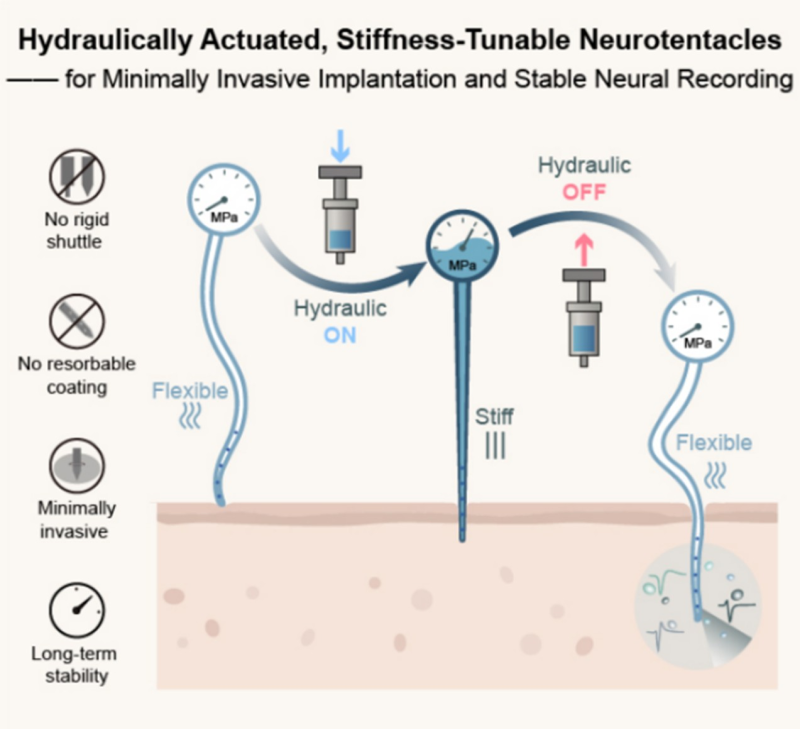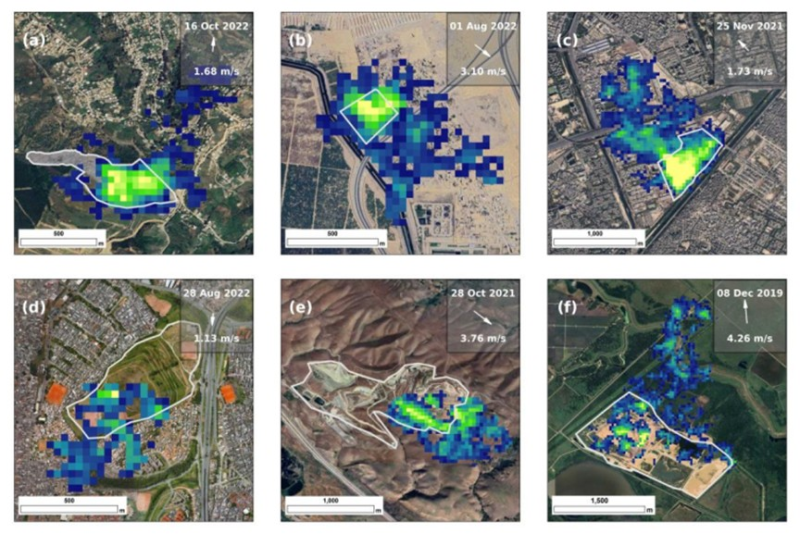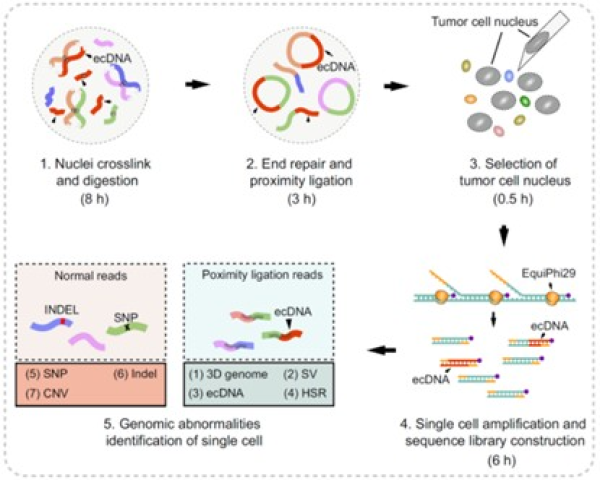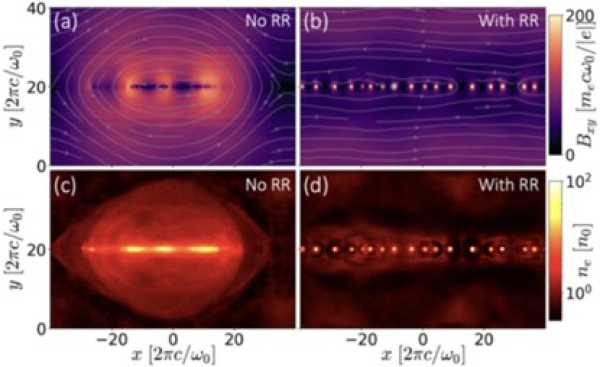Weekly Advanced Technologies〔83〕

Weekly Advanced Technologies〔83〕丨Shape-Shifting Brain Electrode: Adjustable Rigidity Like a Balloon; High-Resolution Satellites Pinpoint Methane Emission Sources in Landfills
Flexible electrodes face penetration challenges in brain tissue due to excessive pliability. Recently, researchers from the Chinese Academy of Sciences have developed a novel 'neural tentacle' probe with tunable stiffness, establishing a groundbreaking approach for neural interfacing.
Methane monitoring faces critical blind spots as landfill emissions remain unquantified. Scientists are now employing space-based observation methods that are transforming global approaches to methane emission tracking."
Based on the weekly diary of technology provided by the daily list of the NCSTI online service platform, we launch the column "Weekly Advanced Technologies" at the hotlist of sci-tech innovation. Today, let's check out No.83.
1. Advanced Science丨Shape-Shifting Brain Electrode: Adjustable Rigidity Like a Balloon

Hydraulically Actuated, Stiffness-Tunable Neurotentacles
In the field of brain-computer interfaces (BCIs), flexible neural electrodes are regarded as the ideal solution for long-term stable neural signal acquisition due to their superior biocompatibility and mechanical properties matching brain tissue. Compared to conventional rigid electrodes, flexible probes significantly reduce tissue damage and inflammatory responses while extending in vivo operational longevity. However, their low-stiffness characteristics create implantation challenges—the inability to self-penetrate brain tissue typically necessitates rigid shuttle devices, which paradoxically exacerbate tissue damage and limit practical applications.
To address this challenge, a collaborative team led by Dr. Liang Jing from the Institute of Psychology and Dr. Pei Weihua from the Institute of Semiconductors at the Chinese Academy of Sciences has developed a novel stiffness-tunable "neurotentacle" probe. This innovation features an integrated microhydraulic system that enables on-demand stiffness switching through internal pressure modulation: pressurization during implantation achieves rigid-state penetration with precision targeting, while depressurization post-implantation returns the probe to its soft state for optimal brain tissue conformability. The entire process eliminates the need for additional rigid insertion tools, achieving true minimally invasive implantation.
Animal studies demonstrate this technology reduces acute tissue damage by >74% and chronic immune responses by ~40% compared to conventional methods. In longitudinal mouse recordings, the probes maintain high signal quality and signal-to-noise ratios (SNR), outperforming traditional approaches in both functional channel counts and identifiable neuron quantities. This breakthrough not only provides a high-performance tool for neural circuit research but also establishes a new paradigm for the practical implementation of flexible electrodes and next-generation minimally invasive neural interface technologies.
2. Nature Climate Change丨High-Resolution Satellites Pinpoint Methane Emission Sources in Landfills

Remote Sensing of Landfill Methane Distribution (a-c: Open dumps; d-f: Sanitary landfills)
Methane (CH₄) is a potent greenhouse gas, with landfills ranking as the third-largest anthropogenic source globally—accounting for ~18% of total emissions. Precise monitoring is therefore critical for climate mitigation. Conventional methods relying on ground-based measurements or model estimations face limitations in spatial coverage, cost efficiency, and accuracy. A research team led by Dr. Cheng Tianhai at the Aerospace Information Research Institute (AIR), Chinese Academy of Sciences, has developed a novel approach leveraging high-resolution satellite remote sensing to accurately quantify methane emissions from landfills.
The research team has adopted satellite data with a spatial resolution of 30 meters and spectral resolution of 10 nanometers. By combining matched filtering and integrated mass enhancement algorithms, they have successfully identified and quantified methane plumes from 102 landfills worldwide, detecting a total of 367 valid emission signals, thereby achieving large-scale, high-precision emission monitoring. The study has also compared two types of landfills: uncovered open dumps and properly operated sanitary landfills. Cross-validation with airborne measurement data has confirmed the reliability of this method. The results show that management methods directly affect emission levels—open dumps have an average methane emission intensity 4.8 times higher than sanitary landfills.
This study has for the first time systematically revealed the impact of different management methods on methane emissions at a global scale, providing scientific basis for improving emission inventories and formulating mitigation policies. This new remote sensing method has significantly enhanced monitoring coverage and accuracy, offering an efficient and scalable technical solution for global methane control.
3. Nature Communications丨Multidimensional Profiling of Malignant Cells via High-Throughput Super-Resolution Cryo-Correlative Microscopy

The Construction Process of Uni-C Single-Cell Multidimensional Genomics Sequencing Library
Pancreatic cancer, characterized by its strong heterogeneity, difficulty in early screening, and limited treatment options, urgently requires more powerful single-cell analysis technologies. A research team led by Dr. Da Lin from the Guangzhou Institutes of Biomedicine and Health, Chinese Academy of Sciences has developed a novel single-cell multi-omics technology named Uni-C. This technology enables simultaneous profiling of large-scale genomic structural variations (e.g., SV, CNV, ecDNA), small-scale mutations (SNP/INDEL), and three-dimensional chromatin architecture within individual cells, achieving multidimensional, high-resolution joint analysis.
The team has applied Uni-C to analyze circulating tumor cells (CTCs) in pancreatic cancer. Despite the extreme rarity of CTCs, Uni-C successfully reconstructed approximately 89% of SNP/INDELs and 75% of structural variations using data from just seven cells, with results highly consistent with primary tumor tissues, validating its high accuracy in rare-cell analysis. Furthermore, the technology has revealed the molecular structure of ecDNA and identified significant differences in chromatin conformation among CTCs at different cell cycle stages, such as A/B compartment remodeling and loss of higher-order structures, providing new insights into assessing tumor cell viability.
Notably, Uni-C has revealed how 3D chromatin structure regulates genes by connecting genomic variants to transcriptional networks. The system has successfully predicted immunogenic neoantigens from mutations, with combined immunotherapy demonstrating potent tumor suppression—highlighting clinical potential. This breakthrough enables rare tumor cell tracking, target identification, and personalized treatment, propelling single-cell multi-omics into precision medicine."
4. Physical Review Letters丨Mysterious Polarized Light from Cluster-Polarized Electrons in Extreme Magnetic Fields

Spatial Distribution of Magnetic Fields and Plasma: a, b depict the magnetic field configurations;
c, d display the electron density profiles.
Magnetic reconnection is a key process for rapid magnetic energy release in extreme astrophysical environments, such as solar flares and black hole jets. Under ultra-strong magnetic fields, electron dynamics enter the "radiation-dominated" regime, where radiation damping and spin effects become critical. However, the underlying evolutionary mechanisms have long remained unclear. Dr. Gong Zheng, an associate researcher at the Institute of Theoretical Physics, Chinese Academy of Sciences, in collaboration with the Max Planck Institute for Nuclear Physics, has made a breakthrough in studying magnetic reconnection in extreme field regimes.
he research team developed an advanced particle simulation system that integrates radiation reaction, electron spin dynamics, and quantum radiation polarization, leading to the first discovery of a novel structure—"spin-polarized condensed plasma"—in radiation-dominated magnetic reconnection. Simulations revealed that under radiation damping, electrons rapidly converge to "helical attractor" fixed points, forming high-density micro-clumps, while their spin directions align with the local magnetic field, achieving near-synchronous polarization.
This condensed state exhibits a density far exceeding that of traditional plasma clumps and is accompanied by unique radiation signatures: the high-energy gamma photons emitted by electrons display anomalous linear polarization, oriented perpendicular to the electron motion plane, significantly deviating from predictions of the classical synchrotron radiation model.
The study reveals that this phenomenon arises because spin-flip processes alter angular momentum transfer, leading to a redistribution of polarization directions. This mechanism provides new theoretical support for explaining anomalous gamma-ray polarization observed in astrophysical sources such as magnetars and the Crab Nebula.
This work has overcome the limitations of traditional plasma models by incorporating spin-dependent radiation effects. We have developed a unified framework that has revealed the fundamental spin-polarization-radiation coupling, providing new tools to investigate cosmic magnetic fields, particle acceleration mechanisms, and extreme plasma states through polarized gamma-ray diagnostics.